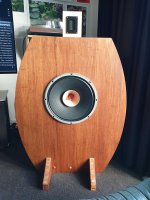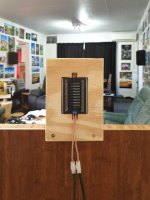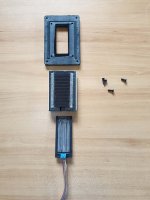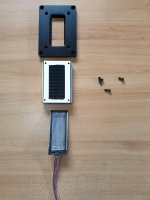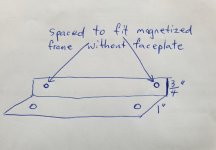AST2560 is a really good choice (I'm using them too). What if you make it dipole by facing one front and a second one to the back instead of taking the felt off?
Hmmm, not sure why you would want to do that. I use the AST2560 as a dipole by removing both the felt on the rear and the mounting plate, and suspending it away from any hard surfaces. I published some data on that configuration in this thread, along with some other dipole drivers:
measurements of nude ribbons and a dome-dipole
To save you the clicks, here is the frequency response family and distortion data taken at 90dB@1m:
Looks good to me when crossed at 2kHz. What more could you want?
I haven't tried it, but I would assume that two back-to-back would just make things worse, possibly at as low as 5kHz. And it would cost twice as much!
Hmmm, not sure why you would want to do that...
Looks good to me when crossed at 2kHz. What more could you want?
I haven't tried it, but I would assume that two back-to-back would just make things worse, possibly at as low as 5kHz. And it would cost twice as much!
There are well regarded speakers that use a front and back arrangement similar to what I'm suggesting. Check Linkwitz's LX521's as an example.
He didn't design his speakers to make them sound "worse" though and yes it adds cost to the speakers. When it chose this design it was for the sound.
Several nice things about this situation.
First, lots of inexpensive tweeters can provide all the tiny bit of top-off needed here.
Easy to prototype the situation.
After listening for a while with a front-speaking tweeter, easy to stick another tweeter on the back any time for a trial.
Too much arm-chair thinking here and speculation about miracles of dipole sound which may bear no importance for an upper treble tweeter.
B.
First, lots of inexpensive tweeters can provide all the tiny bit of top-off needed here.
Easy to prototype the situation.
After listening for a while with a front-speaking tweeter, easy to stick another tweeter on the back any time for a trial.
Too much arm-chair thinking here and speculation about miracles of dipole sound which may bear no importance for an upper treble tweeter.
B.
There are well regarded speakers that use a front and back arrangement similar to what I'm suggesting. Check Linkwitz's LX521's as an example.
He didn't design his speakers to make them sound "worse" though and yes it adds cost to the speakers. When it chose this design it was for the sound.
Actually in terms of the response pattern, the two domes that SL used when designing the LX521 is worse compared to a good dipolar AMT type driver. I wrote about this more in this post:
measurements of nude ribbons and a dome-dipole
SL was very focused on other aspects of the drivers themselves, especially on low HD, IMD and energy storage. The tweeters he used are excellent, but together they just don't make for a very good dipole except at very high frequencies. As a result, he has to push the next lower driver all the way up to 7kHz, where it also is not a good dipole. IMO these are weaknesses of the LX521, but speaker design involves tradeoffs. It doesn't make it "bad" per se, but he chose one thing over another because he could not have both.
Last edited:
Actually in terms of the response pattern, the two domes that SL used when designing the LX521 is worse compared to a good dipolar AMT type driver.
I like Ben's suggestion. He's right it's not that expensive or hard to test.
Actually in terms of the response pattern, the two domes that SL used when designing the LX521 is worse compared to a good dipolar AMT type driver. I wrote about this more in this post:
measurements of nude ribbons and a dome-dipole
I'm not dismissing measurements Charlie but one thing I've found is my old ears like what is probably an old guys sound profile. When measured the standard line isn't what works best for me and after all the speakers are set up for me to listen to. When I measure I have the tweeters set too strong. Old ears, old brain, different room, etc. That's missing from just a speaker test.
I like an active setup because it gives me the option to set up what I want. Your site leads to a rabbit hole I could easily go down, but not to create a perfectly designed, traditional house line.
I'm already using a front/back set up now and could very easily move it back to just 2560's for the highs. I don't want to though. And then there's the fun of trying some things to see what happens.
Grant.
"see what happens" is a fair expectation, whether fun or serious.
Not saying just throwing darts at a target, but quite a bit of unpredictability between the physics of sound system design and the music you experience in your room. That's a gap.
And there's a gap between a mic FR and your experience of music. Perhaps we can get better of putting together a whole bunch of physical measures done in your room and your perceptions.
Today we can bridge the gap with dial-in DSP EQ and a variety of other digital manipulations. Good thing we have REW to note each change as we work iteratively.
B.
Not saying just throwing darts at a target, but quite a bit of unpredictability between the physics of sound system design and the music you experience in your room. That's a gap.
And there's a gap between a mic FR and your experience of music. Perhaps we can get better of putting together a whole bunch of physical measures done in your room and your perceptions.
Today we can bridge the gap with dial-in DSP EQ and a variety of other digital manipulations. Good thing we have REW to note each change as we work iteratively.
B.
Last edited:
Rather painful question if you are hostile to electrolytic, tantalum, and some other caps, as I am (and not sure how they react to surges after being off for a while). Which leaves film capacitors which may be hard to find beyond 20 uF and 50 v.
So, just a matter of basic math for your driver impedance and XO frequency. Even if your cap is tight and takes a bite out of driver output near the XO frequency, that's no big deal or address or ignore.
B.
So, just a matter of basic math for your driver impedance and XO frequency. Even if your cap is tight and takes a bite out of driver output near the XO frequency, that's no big deal or address or ignore.
B.
Took the gamble ;-)
I received the tweeters yesterday and mounted them temporarily on plywood which I screwed to the top of the baffles. I wasn't able to source suitable tweeter-protection capacitors due to our current state of lockdown, so I decided to risk driving them with a 2006 Yamaha receiver. I set the crossover to the tweeters at 2000hz and 48db in the Deqx. I set the Yamaha's gain to 0db which resulted in a pretty good balance with the full-range Lii 15 drivers (sensitivity 97db compared with 95db for the tweeters). They are sounding surprisingly good considering the lack of fine-tuning, the temporary positioning, the un-calibrated Deqx profile, the Yammy receiver etc. I imagine they would only gain cohesiveness if mounted on the baffle near the Lii 15 driver, at ear height. I didn't want to cut a hole to accommodate them until I had some positive feedback from a less than ideal mounting. At present they are about 200mm (8") above seated ear height. They also seem to be remarkably non-directional (non-beaming?). I can move quite a bit (both vertically and horizontally) without seeming to lose the sweet spot, something I most definitely couldn't do with the Maggies. I my have lost some positional definition though - some players don't seem quite as nailed down as they did. Still, it's early days, but an encouraging start. I also have yet to experiment with removal of the faceplate - I did remove one and the inner ribbon slid out of the housing, which felt too vulnerable to me so I screwed the faceplate back on. That didn't secure the inner ribbon though - is that how it's meant to be? (I'll take some pics showing what I mean when I have time)
I received the tweeters yesterday and mounted them temporarily on plywood which I screwed to the top of the baffles. I wasn't able to source suitable tweeter-protection capacitors due to our current state of lockdown, so I decided to risk driving them with a 2006 Yamaha receiver. I set the crossover to the tweeters at 2000hz and 48db in the Deqx. I set the Yamaha's gain to 0db which resulted in a pretty good balance with the full-range Lii 15 drivers (sensitivity 97db compared with 95db for the tweeters). They are sounding surprisingly good considering the lack of fine-tuning, the temporary positioning, the un-calibrated Deqx profile, the Yammy receiver etc. I imagine they would only gain cohesiveness if mounted on the baffle near the Lii 15 driver, at ear height. I didn't want to cut a hole to accommodate them until I had some positive feedback from a less than ideal mounting. At present they are about 200mm (8") above seated ear height. They also seem to be remarkably non-directional (non-beaming?). I can move quite a bit (both vertically and horizontally) without seeming to lose the sweet spot, something I most definitely couldn't do with the Maggies. I my have lost some positional definition though - some players don't seem quite as nailed down as they did. Still, it's early days, but an encouraging start. I also have yet to experiment with removal of the faceplate - I did remove one and the inner ribbon slid out of the housing, which felt too vulnerable to me so I screwed the faceplate back on. That didn't secure the inner ribbon though - is that how it's meant to be? (I'll take some pics showing what I mean when I have time)
Attachments
That looks wonderful.
I find 48 dB slope very helpful. But working with REW (and your ears) will quickly result in a good FR that just can't be achieved by ears alone ever. But mounting tweeters at sides, nearer to Lii might be better if XO is as low as 2kHz. You know tweeter too loud if you "see" music coming from it.
Yes, loss of "cohesiveness" (drivers not concentric enough) might be a problem until you throw a grill cloth over it all so you can't see the drivers any more.
I'm only guessing, but better to stick any old non-polarized caps you have into the amp output since tweeters can be fragile. Does your receiver have a time-delay and relay click at start-up?
Great installation in a handsome room. It is unlike 95% of the rooms posted on this forum that have spare furnishings and must sound awful, you have a carpet and stuffed furniture.
B.
I find 48 dB slope very helpful. But working with REW (and your ears) will quickly result in a good FR that just can't be achieved by ears alone ever. But mounting tweeters at sides, nearer to Lii might be better if XO is as low as 2kHz. You know tweeter too loud if you "see" music coming from it.
Yes, loss of "cohesiveness" (drivers not concentric enough) might be a problem until you throw a grill cloth over it all so you can't see the drivers any more.
I'm only guessing, but better to stick any old non-polarized caps you have into the amp output since tweeters can be fragile. Does your receiver have a time-delay and relay click at start-up?
Great installation in a handsome room. It is unlike 95% of the rooms posted on this forum that have spare furnishings and must sound awful, you have a carpet and stuffed furniture.
B.
Last edited:
I suggest that you try 24dB/oct at 2kHz as well.
If you put the tweeter in the baffle the response will actually get worse. Keep it on top. Reduce the mounting parts to a bare minimum so that you only have the tweeter's own flange. I use this tweeter with the mounting flange removes and it is excellent with the reduced baffle footprint but that makes it challenging to "mount". As long as you don't sit closer than 2m the pathlength difference between drivers will not be too exaggerated and since you are not dialing that in with measurements anyway, why worry about it?
If you put the tweeter in the baffle the response will actually get worse. Keep it on top. Reduce the mounting parts to a bare minimum so that you only have the tweeter's own flange. I use this tweeter with the mounting flange removes and it is excellent with the reduced baffle footprint but that makes it challenging to "mount". As long as you don't sit closer than 2m the pathlength difference between drivers will not be too exaggerated and since you are not dialing that in with measurements anyway, why worry about it?
I can hear the F15 singing the 'straights tune "you're so far away from me". I'd think 2k xover would want the tweeter butt up against the flange of the F15. Yet, you cant mount it into the baffle - it has to be "nude" flying in space with nothing about it. How's that going to be solved?
You could slice the barrel, say 1.5" above the F15, then mount that piece at a right angle (with the top now facing the back of the room) That would help with the bass leak around the otherwise non-existant baffle surface. Now the tweeter is ~10" from the F15 center. I've no idea what the hard baffle plane below and behind the tweeter would do, or if any effect from that could be solved using some kind of absorbent material.
You could slice the barrel, say 1.5" above the F15, then mount that piece at a right angle (with the top now facing the back of the room) That would help with the bass leak around the otherwise non-existant baffle surface. Now the tweeter is ~10" from the F15 center. I've no idea what the hard baffle plane below and behind the tweeter would do, or if any effect from that could be solved using some kind of absorbent material.
Last edited:
Thanks for the responses guys!
@bentoronto - Thanks for your supportive remarks - I have ordered capacitors, but meantime, yes, the receiver has time-delayed startup. I will be measuring the response with REW and the Deqx measurement/calibration system. Lots of trials to come ;-)
@CharlieLaub - I will try your suggestions. If it's not too much trouble, could you please provide closeup pics of your mounted tweeters, and a description of materials/methods used to mount the bare flange? That would be so helpful!
@jjasniew - I'm having trouble visualizing your suggestion. Any chance you could attach a drawing?
@bentoronto - Thanks for your supportive remarks - I have ordered capacitors, but meantime, yes, the receiver has time-delayed startup. I will be measuring the response with REW and the Deqx measurement/calibration system. Lots of trials to come ;-)
@CharlieLaub - I will try your suggestions. If it's not too much trouble, could you please provide closeup pics of your mounted tweeters, and a description of materials/methods used to mount the bare flange? That would be so helpful!
@jjasniew - I'm having trouble visualizing your suggestion. Any chance you could attach a drawing?
I don't mount the flange. I remove the flange and the rear felt of the tweeter in my application and just use the inner parts. Instead of "mounting" that I hang it using wires or fasten it against some perforated aluminum mesh with 0.5" openings. You have to use something non-magnetic to do that because there is a lot of stray flux from the magnets. See the attached pic - its a speaker that I am currently working on.
Anyway, you can certainly use the tweeter and flange as-is. I think you can just sit it on top of the existing baffle and use only the bottom two mounting holes to keep it in place. There is no need to add another baffle just for the tweeter.
Anyway, you can certainly use the tweeter and flange as-is. I think you can just sit it on top of the existing baffle and use only the bottom two mounting holes to keep it in place. There is no need to add another baffle just for the tweeter.
Attachments
Last edited:
Wow! You don't get unwanted resonances from the wire framework?
I'll try your latter suggestion 'use only the bottom two mounting holes to keep it in place'
Cheers
I'll try your latter suggestion 'use only the bottom two mounting holes to keep it in place'
Cheers
The following pics show the component parts of the tweeter after removing the faceplate and felt (front and rear views). The ribbon assembly slid out under its own weight when the faceplate was removed. Is this how it should be? I would have imagined that it would be gued or otherwise securely mounted in the magnetized frame - or is it like this for easy replacement? It appears to be designed to be installed with the cable posts at the bottom, which means the ribbon assembly will tend to slide down as far as the surrounding topology allows. What would you recommend here? And would it be ok to mount the tweeter (minus felt and faceplate) on a right-angled piece of light gauge sheetmetal as in the attached sketch?
Attachments
The inner part with the wires connected to it is the part that actually moves air. It is meant to be replaceable but it is easy to hold in place inside the magnet assembly with some tape if it is loose on your units.
While you can use the tweeter that way, for your application it would be easier to just keep everything assembled and sit the magnet on top of the baffle with the mounting flange just sticking down in contact with the front of your baffle. Would that work/have you tried it, or did you just want to try the "without flange" mounting?
While you can use the tweeter that way, for your application it would be easier to just keep everything assembled and sit the magnet on top of the baffle with the mounting flange just sticking down in contact with the front of your baffle. Would that work/have you tried it, or did you just want to try the "without flange" mounting?
- Home
- Loudspeakers
- Planars & Exotics
- Decware 'Big Betsy' style OB speakers

